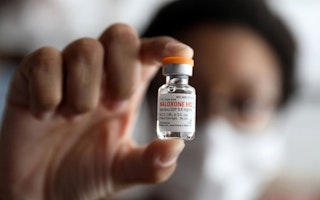Setting the Record Straight on Motherhood and Drug Use, Part II
By Becky Tolson

As this blog has previously noted, pregnant women who use drugs in Eastern Europe often lack access to accurate information, services, and treatment. Public service announcements seeking to scare women into quitting drugs are far more common, with little evidence that this approach works with pregnant women any better than it does with the population at large. Doctors, knowing little about how to treat pregnant women drug users, often simply refuse to provide them with care.
Yet doctors in the United States also fail to provide appropriate treatment to pregnant drug users. In the recent article “Newly Born, and Withdrawing from Painkillers,” the New York Times raised troubling questions about the impact of drug use during pregnancy on babies’ short- and long-term health.
Concerned about the issues the article raises and how they correspond to the facts we do know about pregnancy and drug use, I reached out to three leading experts on the topic:
- Lynn Paltrow, Executive Director of National Advocates for Pregnant Women, New York City.
- Robert Newman, MD, Director of the Baron Edmond de Rothschild Chemical Dependency Institute at Beth Israel Medical Center, New York City.
- Ron Abrahams, MD, Medical Director, Perinatal Addictions Program at the British Columbia Women’s Hospital, and founder of the Fir Square rooming-in program for substance-using women and their babies, Vancouver.
The New York Times stresses the fact that doctors may be reluctant to treat opiate dependence in pregnant women with methadone or buprenorphine, prescribed medications that reduce cravings for illicit opiate drugs. Are these medications safe for women and their babies?
Robert Newman: Methadone and buprenorphine are indeed safe for both mother and child, and there are innumerable studies to support this. This does not mean that adverse effects are never noted. It is important, however, to emphasize, particularly with regard to neonatal withdrawal symptoms that infants can display, that effective treatment can be readily provided, with no short or long-term negative consequences.
What would you say to the doctors described in the article as “ethically conflicted” about treating pregnant drug users?
RN: Abandonment of any patient whose medical condition demands treatment, and for which treatment exists that has been shown to be safe and effective, would seem to violate fundamental ethical canons that have governed the profession for millenia. In the case of the opioid-dependent pregnant woman, such abandonment almost certainly results in continued uncontrolled drug use, lack of prenatal care, inadequate nutrition, high risk of infectious disease, and the daily danger of a fatal overdose. Also, the cycles of “high” and withdrawal that virtually all untreated opioid-dependent people experience pose a severe threat to the fetus.
For all of these reasons, the U.S. Substance Abuse and Mental Health Services Administration has for several years distributed a pamphlet urging pregnant women addicted to opioids to seek methadone maintenance treatment in particular, noting with a conciseness, clarity and bluntness that are not often seen in government documents that “Methadone can save your baby’s life!” Whatever the rationale or rationalization, physicians who refuse to care for the opioid-dependent pregnant woman bear direct responsibility for putting their lives and the lives of their unborn babies at risk.
The article describes the signs of neonatal withdrawal as including irritability, crying, stiff limbs, and diarrhea, as well as a protocol of separating newborns exhibiting these symptoms from their mothers for observation in a darkened room. What has been your experience in treating the babies of drug dependent women?
Ron Abrahams: At Fir Square, we have moved away from using a scoring system to assess whether infants need treatment for neonatal withdrawal syndrome. It is highly subjective and requires the babies to be “observed” in the nursery away from their mothers. In this context, the babies do show withdrawal signs such as excessive crying—but it is “withdrawal” from their mothers!
Instead, we have a rooming-in protocol in which mothers are encouraged and taught how to cuddle and hold their baby. We weigh all the babies daily, ignore subjective symptoms such as coughing, yawning, and small tremors, and really focus on objective symptoms such as diarrhea, vomiting and inability to feed well.
It is important to remember that “normal” babies usually take at least 36-72 hours to settle until the mother’s breast milk comes in and breastfeeding is established. Treatment of withdrawal signs with medication is initiated only if there is weight loss of 10 percent or more after that period and all other possible reasons for the weight loss have been ruled out. We find we can minimize crying, spitting up, and not settling by allowing the babies to be in their mothers’ arms, with plenty of holding and cuddling.
Our experience has demonstrated that rooming-in (the standard of care for newborns of non-substance-using mothers) can reduce the discomfort experienced by substance-exposed newborns, as well as reduce the length of time infants must stay in the hospital, and promote effective mothering.
“Newly Born, and Withdrawing from Painkillers” warns of the unknown long-term effects of prescription opiate misuse during pregnancy, drawing a parallel with the “cocaine-exposed babies of the 1980s.” What do you think of this characterization of the problem?
Lynn Paltrow: The story’s language and structure seems intended to create alarm. As I have highlighted on my organization's blog, it deliberately avoids discussing all that has been learned since the 1980s—including the fact that the alarm about prenatal exposure to cocaine was never justified and that the predicted massive harms never materialized. Such facts finally became so impossible to ignore that the New York Times, a major contributor to the alarm, ran the story “The Epidemic that Wasn’t.”
The Washington Post similarly was forced by the overwhelming weight of evidence-based research to publish a similar story, “Once Written Off, 'Crack Babies' Have Grown into Success Stories.” Research has consistently found that the long-term effects of prenatal exposure to illegal drugs are subtle or nonexistent and particularly so in comparison to such things as poor nutrition and poverty—as well as use of nicotine and alcohol.
Sadly, this most recent Times story follows a familiar style of reporting when it comes to issues involving drugs and pregnant women. It suggests that when “little is known” we can, in the meantime, blame Mom and expect the worse.
To learn more about this issue, watch the short video above, Prenatal Drug Exposure: Award-Winning Pediatrician Discusses What the Science Tells Us.
Until January 2014, Rebecca Tolson was the deputy director of the International Harm Reduction Development Program in the Open Society Public Health Program.

